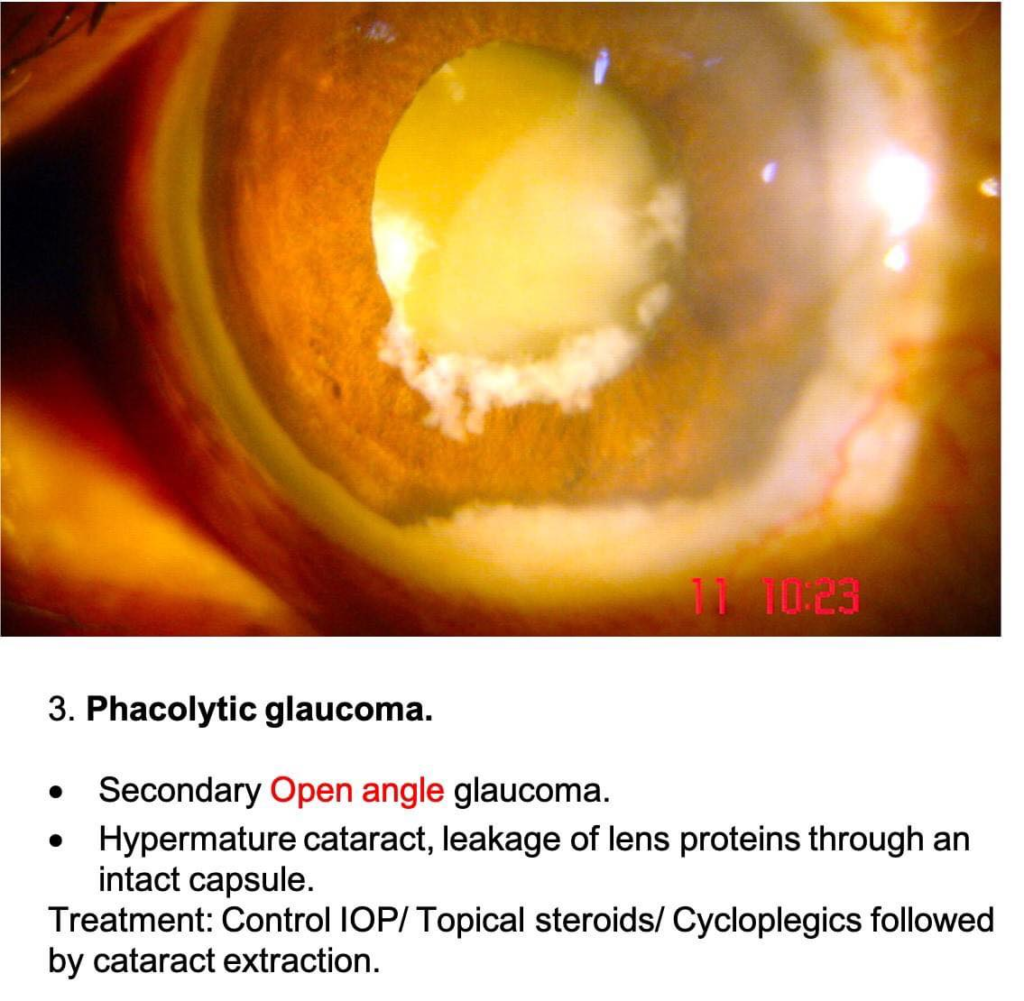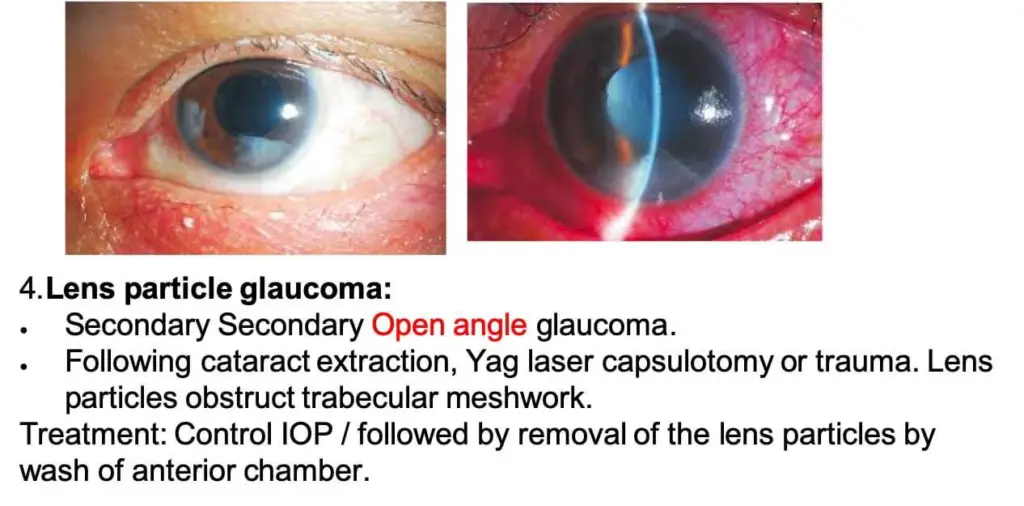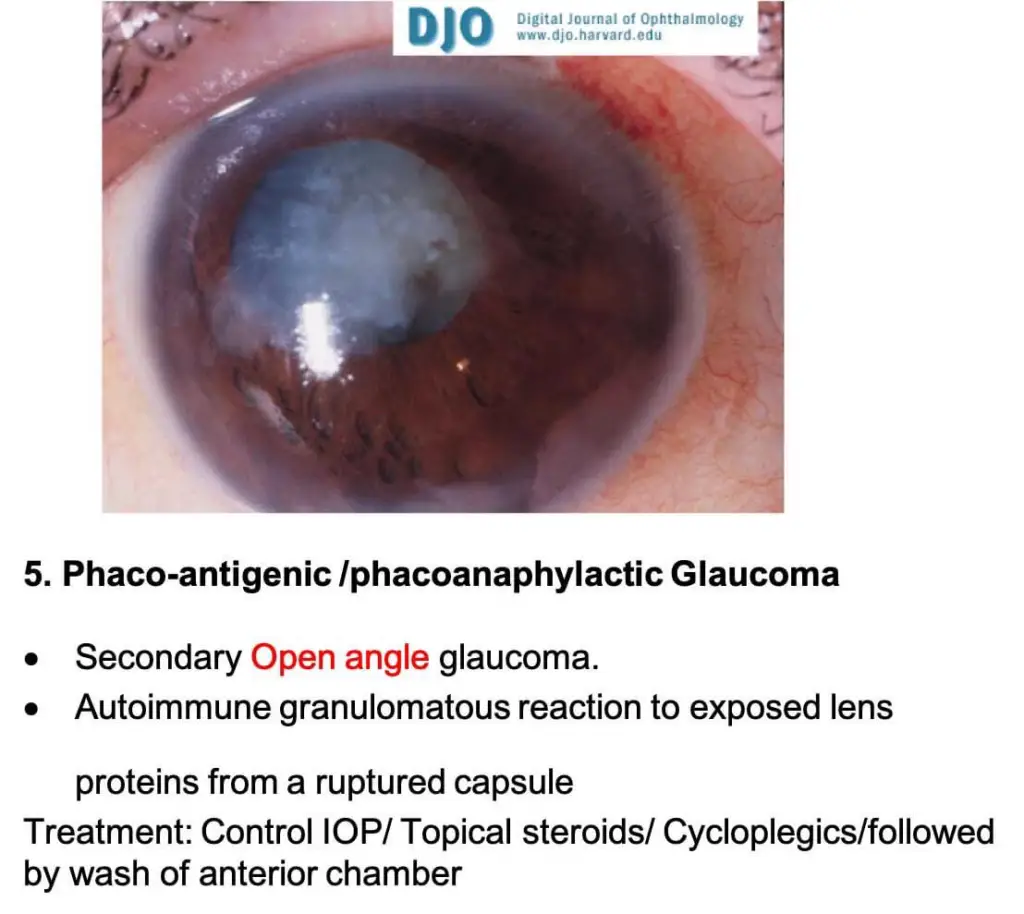Lens induced glaucoma
Lens-induced glaucoma may occur as either secondary angle-closure or open-angle glaucoma. The angle-closure can be caused by lens swelling (phacomorphic glaucoma) or lens dislocation (ectopia lentis). The open-angle glaucomas include glaucoma related to: leakage of lens proteins through the capsule of a mature or hypermature cataract (phacolytic glaucoma), obstruction of the trabecular meshwork following cataract extraction, capsulotomy, or ocular trauma by liberated fragments of lens material (lens-particle glaucoma), and hypersensitivity to own lens protein following surgery or penetrating trauma (phacoantigenic glaucoma). (ref)
Types of Lens induced glaucoma
Lens induced secondary angle-closure glaucoma
1.Phacomorphic Glaucoma
2.Glaucoma induced by Lens-dislocation
Lens induced open-angle glaucoma
1.Phacolytic Glaucoma
2.Lens-Particle Glaucoma
3. Phacoantigenic Glaucoma (formerly known as Phacoanaphylaxis)
What causes lens-induced glaucoma?
Phacomorphic
Intumescent (swollen) cataract pushes the iris narrowing the angle or apposes the pupil margin causing pupillary block.
Phacolytic
A mature cataract leaks denatured lens proteins. Macrophages phagocytose these proteins and clog the Trabecular Meshwork.
Phacoantigenic
Normal lens proteins leak into the AC after trauma or capsule disruption. A granulomatous reaction to these normal
proteins ensues.
what is Lens Particle
Pieces of lens particles (e.g., after cataract surgery) physically obstruct the angle.
What is a pupillary block?
Pupillary Block = The anterior lens comes into contact with the pupillary margin and prevents the normal flow of aqueous

Lens-Induced Glaucoma:![]() Phacomorphic Glaucoma:
Phacomorphic Glaucoma:
It denotes glaucoma due to alteration in morphology of lens.

Phacomorphic Glaucoma is diagnosed by the presence of eye pain, history of decreased vision, evidence of mature cataract formation (slit lamp exam), angle closure (gonioscopy), and elevated intraocular pressure (applanation tonometry) in the affected eye.
1. Intumescent lens.
2. Microspherophakia is generally associated with anterior subluxation or dislocation of lens.

![]() Phacolytic Glaucoma:
Phacolytic Glaucoma:
It occurs due to leakage of proteins from the wrinkled capsule of hypermature morgagnian cataract which block the trabecular meshwork leading to glaucoma.

![]() Lens Particle Glaucoma or Phacotoxic Glaucoma:
Lens Particle Glaucoma or Phacotoxic Glaucoma:
It occurs due to rupture of lens capsule (due to trauma), leading to release of lot of lens particles causing clogging of trabecular meshwork hence causing glaucoma.

![]() Glaucoma Associated with Phacogenic Uveitis:
Glaucoma Associated with Phacogenic Uveitis:
It denotes to the uveitis occurring due to leaked lens proteins and contributing to the development of glaucoma.![]() Glaucoma Associated with Phacoanaphylaxis:
Glaucoma Associated with Phacoanaphylaxis:
It denotes to the anaphylactic reaction, causing accumulation of macrophages, which engulf the lens protein and block the trabecular meshwork leading to glaucoma.

Phacoantigenic glaucoma is a granulomatous inflammatory reaction directed against own lens antigens after surgery or penetrating trauma, leading to obstruction of the trabecular meshwork and increased intraocular pressure.
Credit: Image-Based Review of Ophthalmology.
Photo credit of illustration: EyeFlyMD.
Discover more from An Eye Care Blog
Subscribe to get the latest posts sent to your email.


You must be logged in to post a comment.